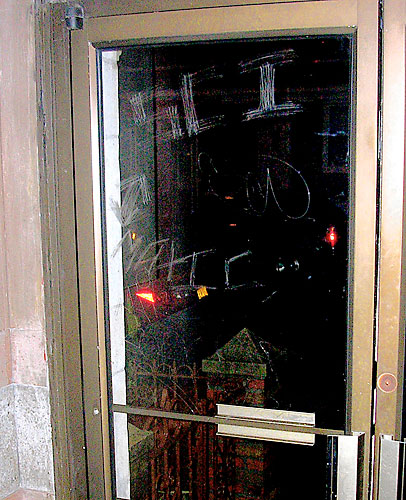When one Kensington woman sees the front door of her building, the scratches on the glass look to her like fingernails on a blackboard sound.
Linda Dalton has lived at the building on E. Second Street between Albemarle Road and Caton Avenue since 1963, and she says in the five decades she’s been there nothing has marred her view of her home more than the scrawls that vandals have etched into the building’s glass doors.
“It makes the building look very run down and very seedy,” said Dalton, who says the vandalized windows have made her hesitant to invite guests over.
The building’s front doors are etched with indecipherable letters that appear to be initials — a form of vandalism called scratchiti that grew in popularity after the Metropolitan Transportation Authority installed shatter resistant windows in its train cars that were easy to mark up with a knife, lava rock, nail file, or even a key. Once vandals caught on to how easy it was, they started tagging other glass surfaces around the city, launching a scourge that annoys the public and graffiti artists alike.
“Scratchiti is not much more well received by aerosol artists as it is by the general public,” according to @149St, a website dedicated to the history of graffiti in New York City. “Due to its nature, complex artistic efforts are not much of an option, making it unappealing for many in the aerosol art culture. Its one advantage for its creators is that it can not be erased.”
The results are ugly, primitive scrawls that are easy to make but expensive to remove, requiring the replacement of expensive plate glass rather than just a quick power wash.
“When I grew up we didn’t have this,” said Dalton. “Why are these landlords not forced to clean up these kind of disgraceful conditions?”
Building owners are required to keep properties in “good repair for tenants,” according to the Department of Housing Preservation and Development, but there’s a limit to what it can enforce. The department issued a violation on Jan. 13 for failure to replace scratch-damaged glass on the entrance door, but because the violation was not hazardous, it was not able to do anything else.
Dalton says she’s tried for years to get her landlord to fix the windows, and claims she’s even offered to pony up the $700 to replace the glass, but to no avail.
“I can’t prevent people from scratching it and if they scratch it again, it’s going to stay scratched,” said Ray Orfaly, the landlord of the building. “Of all the people she’s the only trouble I have. She’s been here forever. You know how much she pays? A two-bedroom $425 a month!”
Dalton doesn’t see it that way.
“We shouldn’t have to live like this!” she said.
Reach reporter Eli Rosenberg at erosenberg@cnglocal.com or by calling (718) 260-2531. And follow him at twitter.com/emrosenberg.























